October 2024 Featured Read: How Far the Light Reaches, by Sabrina Imbler
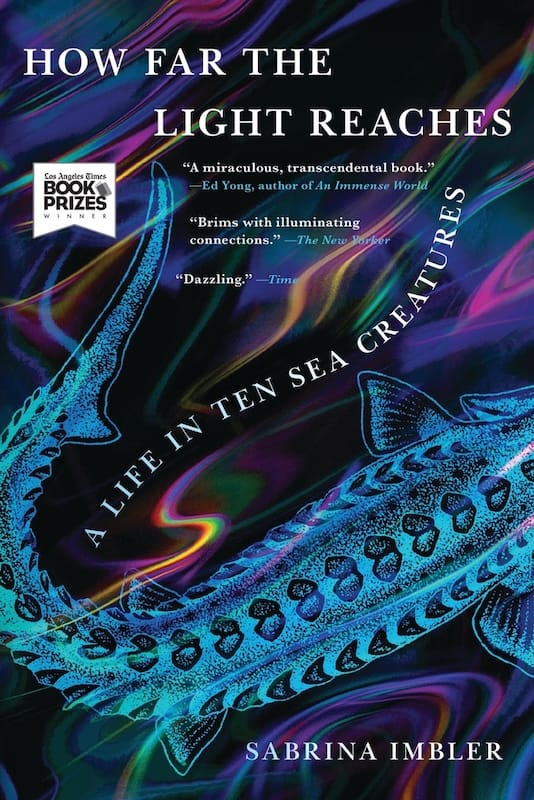
The Monterey Bay Aquarium opened when I was five years old, and growing up in that area, it became one of my favorite places and really one of the only “touristy” places that I really loved. I worked there for two summers, once as a volunteer in high school and once as an intern with the Visitor Presentations department when I was in college. I often say that it was the best place I ever worked. All that is just to say that I have been fascinated with marine life for about as long as I can remember, so it makes sense that I would enjoy an essay collection where the central metaphor is based around the ocean and the creatures that live in it. I do know a fair amount about sea life but there’s always more to learn.
What I did not know and never would have thought of on my own is just how potently marine life works as a metaphor and vehicle for examining queer love, mixed-race identity, family history, body fluidity, and self-knowledge, among other things. Yes, this book is intelligent and insightful and beautiful. Yes, it is moving and affirming. What most surprised me, though, was that while reading it I experienced recognition and joy not only for other people—which I did expect—but also for myself. It’s not to say that I need to see myself in a work of literature in order to appreciate or be moved by it. I don’t. It’s just that I wasn’t expecting to see pieces of myself in this particular work of literature, and yet I did.
As always, if you have thoughts on this book or any of its essays, I’d love to hear them. And if you haven’t read it yet, here are some purchase links:
New KTCO: Sarah Gailey
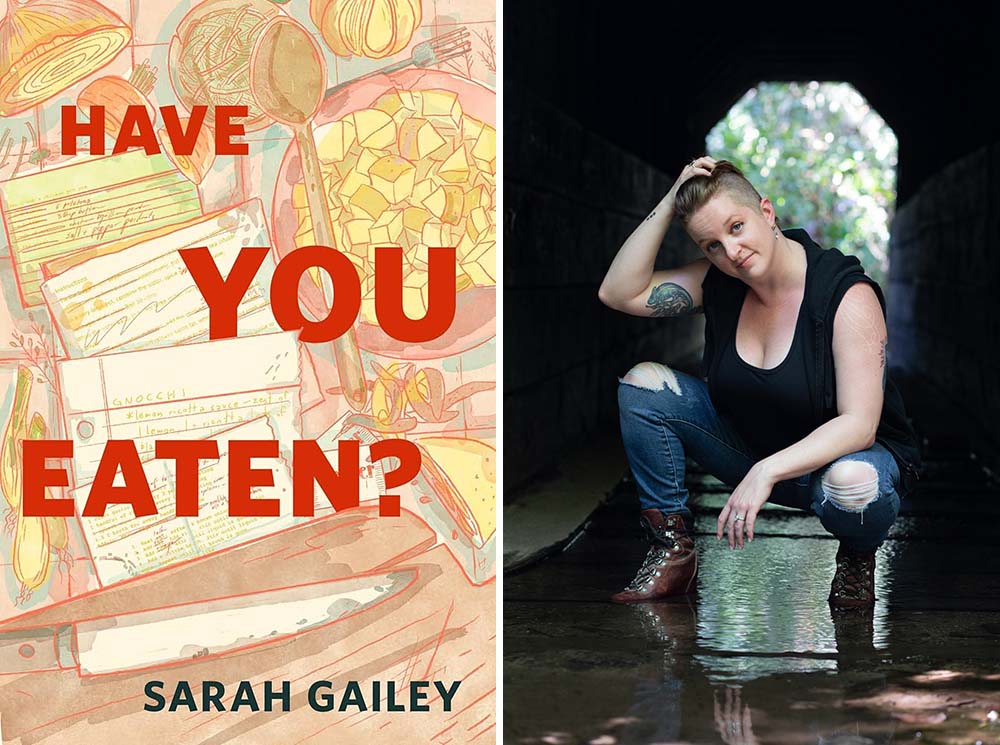
I am always so happy when I get the chance to talk with Sarah Gailey. They’re now officially part of the Four Timers Club on KTCO (along with Rachel Zucker), and I couldn’t be more pleased about it.
For this latest conversation, we talked about Sarah’s new novella, Have You Eaten?, which follows a group of four young, queer friends as they traverse a collapsing America, and which asks the question “What does it look like to take care of each other in a time of crisis?” It’s a question that feels so urgent right now, and for a while now. Sarah and I talked about the experimentation in fiction, vine-ripened tomatoes, cooking as an act of care, and what apocalypse means. And in the second segment, they almost made me cry by being nice to me (though they would vociferously deny that “being nice” was what they were doing, and fair enough), and then we talked about sin-flattening and high-control groups, and the necessity of interpersonal repair.
Hey, It's Me: Breaking Format, Part 2
(CW: cancer, grief)
After the message you heard in the previous episode, it understandably took some time for things to get to a point where Rachel and I could sit down and record a conversation. When your son gets diagnosed with terminal cancer, it changes a lot about your life. But eventually we did find a time to talk to each other about what her life has been like since her son’s diagnosis. It is, as you might expect, a difficult conversation. But I suppose that is what we’re here for.
Hey It's Me: Breaking Format
(CW: cancer, grief)
It’s kind of a strange thing to be making a podcast that is more or less about just ourselves, and one of the stranger parts of it is recording the episodes so far in advance of when we release them. The version of us that you hear in an episode when it posts is not the same as the one living in the world on that same day. That’s always been true, and it’s always true of any podcast. But Rachel’s life has changed a lot recently, and in very difficult ways, and it’s felt a little weird that the show hadn’t caught up to that yet. Well, now it has. Rachel’s son has cancer, which she found out not long before the message she sent me that we’re sharing as this episode.
This episode is different from our previous ones, in form and in content. It’s kind of hard to listen to—though, at that, not as hard as living through the things Rachel talks about. But if this show is about us, then this is where we are right now. Or, at least, it’s where we were at the time we recorded these messages. Life continues to proceed, often painfully, sometimes with spots of peace or joy or levity. We don’t know what we’re doing, but we’re doing our best.
September 2024 Featured Read: Have You Eaten?, by Sarah Gailey
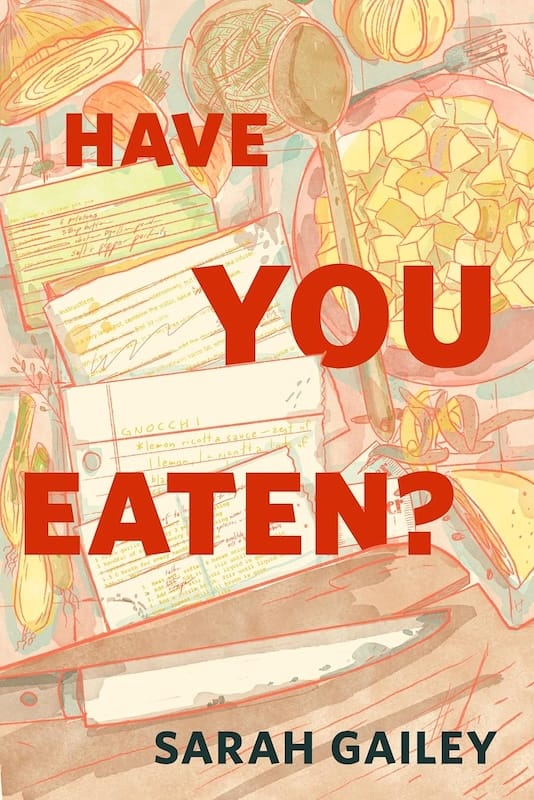
I have been a fan of Sarah Gailey’s writing since before they published their first book, River of Teeth, back in 2017. I’m always happy when I get to read something new from them, in part because, yes, they are one of my favorite writers and I know that it will be a good read in and of itself. But it’s also been wonderful and just interesting to watch their progression as a writer, to see their skills continue to grow, and to see what through-line emerges. I think one of those through-lines is the fundamental tenderness that Gailey’s stories have toward their characters.
Here, we follow a group of young, queer refugees as they make their way through a near-future America that is in the process of collapsing. There are echoes, perhaps, of Alas, Babylon in the broad strokes of the story and setting, but what’s so interesting and vital about the approach Have You Eaten? takes to the post-apocalyptic genre is that each chapter takes place in the in-between. The travel and conflict that we expect from the genre mostly takes place off-screen, and what we see instead are the quieter, more personal moments during which this little family finds ways to nourish each other, both literally and emotionally. What are the ways we take care of each other in a crisis? That’s what the story is asking. The answers are sometimes messy, sometimes imperfect, but there is a core of love in every interaction that shines through. The result is lovely. I hope you’ll read it.
Here are some purchase links:
What If I'm Wrong?
I’m going to share an anecdote that, on its own, probably seems small and possibly even a little petty, but it’s my hope that this will take us somewhere.
I went through a period last year of making banana bread regularly. I’m not much of a baker, but banana bread is fairly easy and the recipe in Joy of Cooking has always turned out well enough for me. (This is the thing about Joy: the recipes in that book are never the best or most interesting but they are always at the very least good enough, and, more importantly, they’re very achievable for beginning cooks. I learned how to cook a lot of things from my mom’s old 1970s copy of Joy when I was a kid, and when I moved into my first apartment, she bought me a copy of my own to help make it a home.)
In any case, one day late in the year I was working from home and decided to take advantage of some down time to make a couple of loaves of banana bread, and when they were done I posted a picture to Facebook with the caption “WFH day.” I’m not entirely sure why I feel compelled to post so many pictures of my food to the internet but it’s at least in part a sort of proof of life and in part a form of showing off. The loaves were surely imperfect but they were good enough for me, and I was happy enough with them to want to show people.
People usually like my food pictures, so I was a little surprised when a guy I only peripherally knew popped up in the comments to tell me what I’d done wrong. Now, having a relative (or total) stranger come out of nowhere to criticize something I’m happy about is not a new experience for me, nor for most people who spend any amount of time on the public internet. But just because it’s a common occurrence doesn’t make it a pleasant one, so I responded and let him know that I thought unsolicited criticism is rude, especially when it’s about something I’m happy about. To which he responded by accusing me of attacking him, and ultimately him telling me to fuck off and blocking me.
In retrospect, I could have phrased my pushback differently. Instead of framing things in terms of his behavior (“that’s rude”), I could have focused instead on how it impacted me (“that hurts my feelings”). That might have gotten a more thoughtful, less defensive response. Still, as much as it might be beneficial to me to be able to consider someone else’s feelings when they hurt me, and as much as I do try to do just that, it still always strikes me as unjust.
But, more than that, I can’t help thinking how rare it has been in my life to get a real apology about anything. How most times, no matter how I phrase things, telling someone that they have hurt me simply makes the person angry with me for making them feel bad about themselves, and resentful for having to consider my feelings. Or sends them into a spiral of self-loathing that I then have to pull them out of by minimizing my own pain, and that results in no change or real self-reflection. Or results in them simply dismissing me, telling me that I am wrong for being hurt. But how few times it has ever resulted in the person being curious about me, in them making an attempt to understand rather than judge or defend, in them trying to make amends, or at least stop doing the thing that hurt me.
All of this came up for me as I was listening to the latest episode of Between the Covers, in which David Naimon talked with British-Palestinian author Isabella Hammad about her recent book, Recognizing the Stranger: On Palestine and Narrative, and the lecture that it was based on. At one point, talking about moments of recognition and what stands in the way of such moments, Hammad says this:
Isabella Hammad: The lecture I gave is about recognition, but the opposite of recognition is denial. And I think that, first of all, the West is in denial in many ways. Less and less so. More and more people are confronting what’s happening, among the populace. But the institutions, the cultural institutions, the universities are denialist institutions. And I think it’s quite helpful to talk about denialism as a kind of phenomenon. Which is a denialism not only about Palestine but about structures of empire and genocidal histories which are, you know, not acknowledged. . . . So, there’s an ongoing denial about these histories which are now coming to the surface. So, you know, we’re seeing sort of the tip of the iceberg but there’s huge mass underneath. And there’s no wonder that people are in denial, because to confront that reality is to confront many things that structure their lives and structure their societies, and that’s really scary. I understand that that’s really scary.
Now, I want to be clear: I am certainly not equating an abrasive internet interaction with genocide. That would be wildly irresponsible and harmful, that kind of flattening. What I am saying is that hearing Hammad talk about how hard it is for people to have to confront the uncomfortable realities that structure their lives and societies, that made me think again about how great harms are so easily facilitated by the inability to consider that oneself might be in the wrong, that oneself or one’s people or one’s state might be the oppressor. How thinking of oneself as the victim can be and so often is used to excuse great harm. And that is true at both the personal level and the global level.
I believe that on some level, conflict is inevitable when people are in contact. On the level of individuals, the closer two people are, the more certain it is that they will hurt each other and come into conflict. And the question, then, is how to resolve that conflict. What do we do when someone tells us “You have hurt me”? In the best of circumstances, I think, we can say “It wasn’t my intention to hurt you, but I see that I have.” We can demonstrate that we understand why what we’ve done was hurtful. We can say, truthfully, that we are sorry. And we can commit to trying not to do the hurtful thing again.
In order to get to that kind of real apology, though, we have to be able to take ourselves and our own intentions and how we want to see ourselves out of the center of the interaction. And that is hard to do. It often feels like it’s too hard for most people. And so instead we will say, “I didn’t mean to hurt you, and you should focus on that instead.” Or we say, “No reasonable person would be hurt by that.” Or, “Well now you’re hurting my feelings, so we’re even.” Or, “I can’t do anything right, can I?” Our own sense of emotional self-preservation keeps us from looking inwards, because to do so would be too painful. And so it keeps us from making amends.
I don’t know if fascism and genocide, patriarchy and white supremacy, can be defeated by learning how to apologize on an individual level. Probably not. Probably, those forces are bigger than what can be influenced by anything anyone does individually. And even if these problems could be solved with individual compassion, I don’t know how to convince anyone to choose compassion and curiosity in the face of emotional pain. But I know that my own moral journey wasn’t able to really start until I was able to first ask “What if they’re right and what if I’m wrong?” And at least this feels like something I can get my arms around. The world is too big to change. But maybe I can help a person change themselves, if they’re open to it.
New KTCO: Rachel Edelman
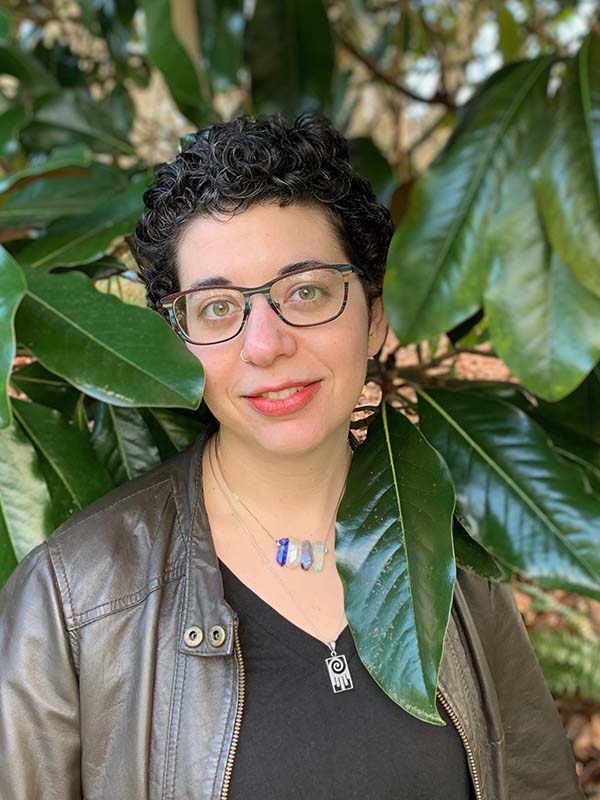
I had a chance to read Rachel Edelman’s debut poetry collection, Dear Memphis, this past spring, and I was struck by how familiar the feelings and questions of these poems felt to me. Questions about what it means to be from a place where you and your people are held apart. About what heritage and inheritance mean, about the difference between exile and diaspora and migration. About being part of a minoritized, oppressed group that nevertheless experiences privilege, and sometimes participates in the oppression of others. About what home means. For Edelman’s speaker, these questions arise from being Jewish in the South. For me, similar questions arise from being Japanese American. It’s not the same, of course, but the way our experiences seemed to rhyme intrigued me, and led to a wonderful conversation about the book, about self-awareness, and about connection through letter-writing.
Hey, It's Me: Episodes 6 and 7
For September’s first episode of Hey, It’s Me, I wanted to talk about Chappell Roan’s album The Rise and Fall of a Midwest Princess. More specifically, I wanted to talk about why it wasn’t quite hitting for me, despite being a breakout hit and despite the fact that I both appreciate and admire it. That led to a broader discussion about participating in culture that isn’t your own, and how respectful distance can be problematic.
Then, for the second episode, Rachel sent me the audio for a forthcoming episode of Commonplace, in which the guest was her undergraduate photography mentor, Lois Conner. I should note here that that Commonplace episode is still forthcoming, so you can’t listen to it yet. But I think that our conversation about the episode is still interesting and comprehensible without listening to Rachel’s conversation with Conner, because we’re talking less about the details of the audio and more about things like the nature of photography, why we make podcasts, and what it means to give attention (and to want it).
August 2024 Featured Read: The Sense of Wonder, by Matthew Salesses
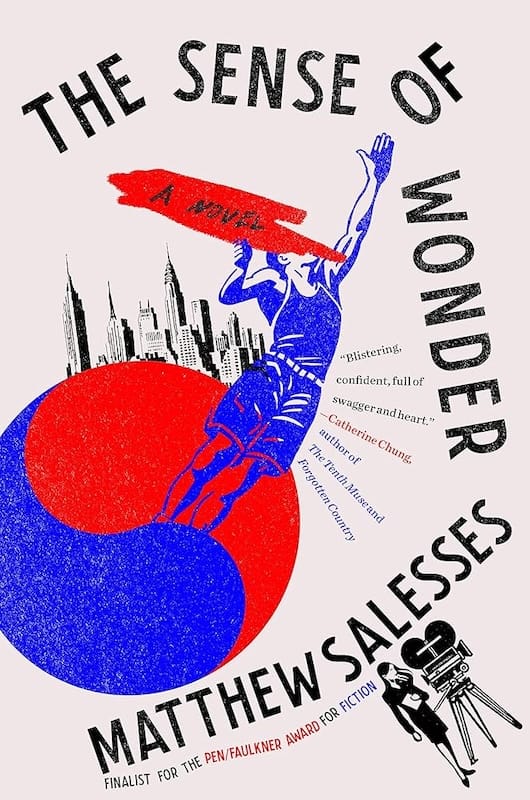
Not too far into the second section of Matthew Salesses’s latest novel, The Sense of Wonder, Carrie Kang—a Korean American K-drama producer—explains to the reader that “Unlike in Hollywood, in Korea, plot happens because of who people are, not because of what they choose.” Added together with the book’s opening, in which the other main character—Won Lee, the only Asian American player in the NBA—recounts a racist joke about an Asian American basketball player, I think you have a key to understanding what this story is about.
The Sense of Wonder is very much inspired by Jeremy Lin’s rise and fall in the NBA, something that Salesses wrote about back in 2012, just before Lin’s season was ended due to injury. Here, instead of “Linsanity,” Won’s sudden success is dubbed “the Wonder,” but the parallels are clear. We also see the ways that K-drama informs the book via Carrie’s sections and the romantic relationship between Won and Carrie.
I’d previously read Salesses’s novel Disappear Doppelgänger Disappear (and spoke with him about the book on Keep the Channel Open), a book that I loved for its strangeness and the way it literalizes the “split subject” phenomenon of Asian Americanness. I also loved this one, but where Doppelgänger felt experimental and often unsettling, Wonder feels more straightforward. Don’t mistake me: this book is intelligent and incisive and complex in its commentary on race, relationships, culture, family. It’s moving and resonant in how it presents its characters. It’s funny and tragic and redemptive. But the text is also accessible and propulsive in a way that had me rocketing through the book in just a couple of sittings. I don’t know that I could say which book is better, just that the experience of reading them was very different, and that I thought both were excellent.
Have you read this one? I’d love to hear what you thought of it if you have. And if you haven’t, here are some purchase links:
Great (Genre) Expectations
I’ve been thinking about genre a bit lately. Well, it’s more accurate to say that I’ve been thinking about genre pretty regularly for the past twenty-odd years, ever since taking a single class on film genres in my senior year of college. In any case, last week I was listening to David Naimon’s conversation with Vajra Chandrasekera, in which they discussed both Chandrasekera’s first novel, The Saint of Bright Doors, and his second, Rakesfall. As in every episode of Between the Covers, the conversation was wide-ranging and thought-provoking, just excellent all around. But the part that has stuck most in my mind was this part toward the beginning:
David Naimon: I want to spend some time exploring some of the questions your first book raises as a way to prepare us to discuss Rakesfall, especially because some of the things that are true about your first book are an order of magnitude more true about your second. Saints was mainly met with thunderous critical acclaim but also at the same time, with a much smaller number of equally passionate people who were dissenters with the book, a recent focus for instance on a popular podcast that roasts books, what these two camps have in common is a sense of, “What the f*ck” or “What is this?” The larger group is thrilled by this experience. The smaller group is put off by it.
The Saint of Bright Doors is, I would say, recognizably a part of the fantasy genre insofar as it is set in a second world where magic and magical creatures exist. It is also shelved as fantasy in bookstores and libraries, and was published by Tor, a publisher known for speculative fiction. Yet a reader who is well-versed in mainstream American fantasy fiction would, as David noted, likely find this book confusing in that it doesn’t do what fantasy novels usually do. For one example, consider: in the opening of the book we are presented with the main character, Fetter, who is raised by his mother to be the perfect assassin to kill his father, a messianic figure in one of the religions of the book’s world. In a typical fantasy, this sort of setup would lead directly into a hero narrative in which Fetter learns his craft as an assassin and goes on a quest to find and slay his father, culminating in some sort of battle (literal or figurative) between father and son.
But this isn’t what happens in The Saint of Bright Doors. Instead, within the first chapter or so, Fetter rejects his mission, moves to the city, and joins a support group for cast-off Chosen Ones. It’s clear that this is at least in part because Chandrasekera is deliberately subverting genre expectations. And, as David noted, readers have found that subversion either delightful or frustrating. That different readers will respond differently to the same text is, of course, about as surprising as water being wet, but I’m particularly interested in looking at how genre functions in terms of our understanding of a text.
I occasionally try to talk about genre on social media but often find myself frustrated by the fact that most of the responses I get—when I get any responses at all—take a prescriptive approach to genre. People will talk about where a book would (or should be) shelved. People will talk about genre as a set of rules to be followed. And people will frequently describe the quality of a book in terms of how closely it follows those rules—a good book is one that follows its genre rules, a bad book is one that does not. But however much my probably-autistic brain enjoys pattern-finding and categorization, this kind of discourse around genre is my least favorite and the least interesting to me.
Let me throw out a few ideas that are fairly standard and not at all new in academic discussions of genre (certainly they were not new ideas when they were presented to me in that film studies class 23 years ago):
- Genre is an emergent property of literature. It is a conversation between texts, readers, and writers. Any time audiences and authors are aware of more than one text, comparisons and contrasts are going to be made between texts and patterns are going to be noticed. And once the patterns are noticed, authors are going to generate new texts that incorporate an awareness of those patterns. This is the process by which genres arise, are propagated, and are utilized by authors and audiences.
- Genre definitions are always going to be imprecise because they arise out of the texts that make up the body of the genre, rather than being imposed from the top-down by some sort of authority figure. Because there is no central authority, each reader and each author has to negotiate between our own understanding of a genre and everyone else’s understanding of it. In that way, it’s a lot like most other forms of communication.
- Because genre definitions are imprecise and decentralized, the boundaries of every genre is going to be fuzzy. What that means is that while there are always going to be many works that are completely non-controversially included as part of a genre—The Lord of the Rings as fantasy, for example, or the Sherlock Holmes stories as mysteries—there are also always going to be many works where it’s unclear or at least non-unanimous whether they should be included in a genre.
- A single work of art can meaningfully be a part of more than one genre. Not only does that mean that one book can include tropes and structures from multiple genres, but it also means that we can analyze and understand a single book from multiple genre angles at the same time.
- No single text ever incorporates every trope or structure or characteristic of a given genre. That doesn’t prevent it from participating in that genre.
- Because human brains look for patterns, a major way that genres operate is by creating expectations in the audience. Whether a given text upholds or subverts its genre’s expectations—or, rather, which expectations it upholds and which it subverts—is a valuable key to its meaning.
If we let go of the idea of genre as a set of rules and instead use it as an interpretive lens, so much can be opened up! Consider: once upon a time, I tried to have an open-ended conversation on social media about genre, and one person who responded to me brought up the example of Star Wars, and how it would be ridiculous to consider Star Wars a Western. The ironic thing is that among the reading I was assigned for that film genres class I mentioned above was an essay all about analyzing Star Wars as a Western! Sure, you can point out that Star Wars doesn’t take place in the American West. There aren’t literal cowboys or horses or six-shooters. But a lot of the iconography of especially A New Hope is clearly drawn from Westerns, as are many aspects of the plot structure. Rather than saying “Star Wars is not a Western”—which simply ends the conversation—if we say that Star Wars is a Western, it allows us to take all of the analysis and discussion around a century of Western film and literature and apply those to our understanding of this other work. We can ask questions like “Why would an ostensibly science fiction movie choose to uphold these tropes of the Western genre, and what meaning can we draw from that?” And if Star Wars isn’t your thing, you can ask these same kinds of questions about any text that participates in a genre, which is to say any text at all.
Now, I do think that at least part of what many people were responding to with The Saint of Bright Doors was about novelty. Certainly I had never read a book like that before, and when you read a lot, sameness can get boring. In that case, something new can often be something exciting.
On the other hand, lots of people also read to be comforted or to be entertained in familiar ways, in which case novelty may not be welcome except within certain boundaries. And, to be clear, there’s nothing wrong with that. People can read however they want, toward whatever end they want. And people have lots of opportunity to read that way if they want to. I often want to read that way. I often do read that way.
But, for me at least, those comforting, familiar genre reads are often not the ones that I find interesting to talk about. I’m glad they’re there when I want them. But when I really want to dig into a conversation about a book, I’m glad that there are books that challenge genre expectations, too.
If I were a smarter reader, I’d probably launch here into a discussion about the ways that The Saint of Bright Doors subverts genre and why and what it means. Alas, I am not equipped to write that essay. Not yet, anyway. If you’re interested in that conversation, David’s episode with Chandrasekera is a good place to start. Let me know how it goes!